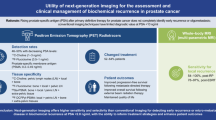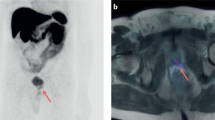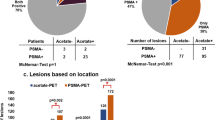Abstract
The patient population with a rising prostate specific antigen (PSA) post-therapy with no evidence of disease on standard imaging studies currently represents the second largest group of prostate cancer patients. Little information is still available regarding the specificity and sensitivity of positron emission tomography (PET) tracers in the assessment of early biochemical recurrence. Ideally, PET imaging would allow one to accurately discriminate between local vs nodal vs distant relapse, thus enabling appropriate selection of patients for salvage local therapy. The vast majority of studies show a relatively poor yield of positive scans with PSA values <4 ng ml−1. So far, no tracer has been shown to be able to detect local recurrence within the clinically useful 1 ng ml−1 PSA threshold, clearly limiting the use of PET imaging in the post-surgical setting. Preliminary evidence, however, suggests that 11C-choline PET may be useful in selecting out patients with early biochemical relapse (PSA <2 ng ml−1) who have pelvic nodal oligometastasis potentially amenable to local treatment. The role of PET imaging in prostate cancer is gradually evolving but still remains within the experimental realm. Well-conducted studies comparing the merits of different tracers are needed.
This is a preview of subscription content, access via your institution
Access options
Subscribe to this journal
Receive 4 print issues and online access
$259.00 per year
only $64.75 per issue
Buy this article
- Purchase on Springer Link
- Instant access to full article PDF
Prices may be subject to local taxes which are calculated during checkout

Similar content being viewed by others
References
Scher HI, Heller G . Clinical states in prostate cancer: toward a dynamic model of disease progression. Urology 2000; 55: 323–327.
Scher HI, Eisenberger M, D'Amico AV, Halabi S, Small EJ, Morris M et al. Eligibility and outcomes reporting guidelines for clinical trials for patients in the state of a rising prostate-specific antigen: recommendations from the Prostate-Specific Antigen Working Group. J Clin Oncol 2004; 22: 537–556.
Pound CR, Partin AW, Eisenberger MA, Chan DW, Pearson JD, Walsh PC . Natural history of progression after PSA elevation following radical prostatectomy. JAMA 1999; 281: 1591–1597.
Graefen M, Karakiewicz PI, Cagiannos I, Quinn DI, Henshall SM, Grygiel JJ et al. International validation of a preoperative nomogram for prostate cancer recurrence after radical prostatectomy. J Clin Oncol 2002; 20: 3206–3212.
Kattan MW, Zelefsky MJ, Kupelian PA, Scardino PT, Fuks Z, Leibel SA . Pretreatment nomogram for predicting the outcome of three-dimensional conformal radiotherapy in prostate cancer. J Clin Oncol 2000; 18: 3352–3359.
Kattan MW, Potters L, Blasko JC, Beyer DC, Fearn P, Cavanagh W et al. Pretreatment nomogram for predicting freedom from recurrence after permanent prostate brachytherapy in prostate cancer. Urology 2001; 58: 393–399.
Kattan MW, Zelefsky MJ, Kupelian PA, Cho D, Scardino PT, Fuks Z et al. Pretreatment nomogram that predicts 5-year probability of metastasis following three-dimensional conformal radiation therapy for localized prostate cancer. J Clin Oncol 2003; 21: 4568–4571.
Moul JW, Ward JF . Management of the patient with a rising PSA alone. Hematol Oncol Clin North Am 2006; 20: 897–908.
Ward JF, Moul JW . Rising prostate-specific antigen after primary prostate cancer therapy. Nat Clin Pract Urol 2005; 2: 174–182.
D'Amico AV, Whittington R, Malkowicz SB, Cote K, Loffredo M, Schultz D et al. Biochemical outcome after radical prostatectomy or external beam radiation therapy for patients with clinically localized prostate carcinoma in the prostate specific antigen era. Cancer 2002; 95: 281–286.
Stephenson AJ, Shariat SF, Zelefsky MJ, Kattan MW, Butler EB, Teh BS et al. Salvage radiotherapy for recurrent prostate cancer after radical prostatectomy. JAMA 2004; 291: 1325–1332.
Valicenti RK, Gomella LG, Perez CA . Radiation therapy after radical prostatectomy: a review of the issues and options. Semin Radiat Oncol 2003; 13: 130–140.
Bianco Jr FJ, Scardino PT, Stephenson AJ, Diblasio CJ, Fearn PA, Eastham JA . Long-term oncologic results of salvage radical prostatectomy for locally recurrent prostate cancer after radiotherapy. Int J Radiat Oncol Biol Phys 2005; 62: 448–453.
Consensus statement: guidelines for PSA following radiation therapy. American Society for Therapeutic Radiology and Oncology Consensus Panel. Int J Radiat Oncol Biol Phys 1997; 37: 1035–1041.
Horwitz EM, Vicini FA, Ziaja EL, Dmuchowski CF, Stromberg JS, Martinez AA . The correlation between the ASTRO Consensus Panel definition of biochemical failure and clinical outcome for patients with prostate cancer treated with external beam irradiation. American Society of Therapeutic Radiology and Oncology. Int J Radiat Oncol Biol Phys 1998; 41: 267–272.
Horwitz EM, Thames HD, Kuban DA, Levy LB, Kupelian PA, Martinez AA et al. Definitions of biochemical failure that best predict clinical failure in patients with prostate cancer treated with external beam radiation alone: a multi-institutional pooled analysis. J Urol 2005; 173: 797–802.
D'Amico AV, Cote K, Loffredo M, Renshaw AA, Schultz D . Determinants of prostate cancer-specific survival after radiation therapy for patients with clinically localized prostate cancer. J Clin Oncol 2002; 20: 4567–4573.
D'Amico AV, Kantoff P, Loffredo M, Renshaw AA, Loffredo B, Chen MH . Predictors of mortality after prostate-specific antigen failure. Int J Radiat Oncol Biol Phys 2006; 65: 656–660.
Lee AK, D'Amico AV . Utility of prostate-specific antigen kinetics in addition to clinical factors in the selection of patients for salvage local therapy. J Clin Oncol 2005; 23: 8192–8197.
Connolly JA, Shinohara K, Presti Jr JC, Carroll PR . Local recurrence after radical prostatectomy: characteristics in size, location, and relationship to prostate-specific antigen and surgical margins. Urology 1996; 47: 225–231.
Leventis AK, Shariat SF, Kattan MW, Butler EB, Wheeler TM, Slawin KM . Prediction of response to salvage radiation therapy in patients with prostate cancer recurrence after radical prostatectomy. J Clin Oncol 2001; 19: 1030–1039.
Hricak H, Schoder H, Pucar D, Lis E, Eberhardt SC, Onyebuchi CN et al. Advances in imaging in the postoperative patient with a rising prostate-specific antigen level. Semin Oncol 2003; 30: 616–634.
Schöder H, Herrmann K, Gonen M, Hricak H, Eberhard S, Scardino P et al. 2-[18F]fluoro-2-deoxyglucose positron emission tomography for the detection of disease in patients with prostate-specific antigen relapse after radical prostatectomy. Clin Cancer Res 2005; 11: 4761–4769.
Akin O, Hricak H . Imaging of prostate cancer. Radiol Clin North Am 2007; 45: 207–222.
Charron M, Beyer T, Bohnen NN, Kinahan PE, Dachille M, Jerin J et al. Image analysis in patients with cancer studied with a combined PET and CT scanner. Clin Nucl Med 2000; 25: 905–910.
Schoder H, Erdi YE, Larson SM, Yeung HW . PET/CT: a new imaging technology in nuclear medicine. Eur J Nucl Med Mol Imaging 2003; 30: 1419–1437.
Oyama N, Miller TR, Dehdashti F, Siegel BA, Fischer KC, Michalski JM et al. 11C-acetate PET imaging of prostate cancer: detection of recurrent disease at PSA relapse. J Nucl Med 2003; 44: 549–555.
Kotzerke J, Volkmer BG, Neumaier B, Gschwend JE, Hautmann RE, Reske SN . Carbon-11 acetate positron emission tomography can detect local recurrence of prostate cancer. Eur J Nucl Med Mol Imaging 2002; 29: 1380–1384.
de Jong I, Pruim J, Elsinga PH, Vaalburg W, Mensink HJ . 11C-choline positron emission tomography for the evaluation after treatment of localized prostate cancer. Eur Urol 2003; 44: 32–38.
Sandblom G, Sorensen J, Lundin N, Haggman M, Malmstrom PU . Positron emission tomography with C11-acetate for tumor detection and localization in patients with prostate-specific antigen relapse after radical prostatectomy. Urology 2006; 67: 996–1000.
Albrecht S, Buchegger F, Soloviev D, Zaidi H, Vees H, Khan HG et al. (11)C-acetate PET in the early evaluation of prostate cancer recurrence. Eur J Nucl Med Mol Imaging 2007; 34: 185–196.
Cimitan M, Bortolus R, Morassut S, Canzonieri V, Garbeglio A, Baresic T et al. [(18)F]fluorocholine PET/CT imaging for the detection of recurrent prostate cancer at PSA relapse: experience in 100 consecutive patients. Eur J Nucl Med Mol Imaging 2006; 33: 1387–1398.
Scattoni V, Picchio M, Suardi N, Messa C, Freschi M, Roscigno M et al. Detection of lymph-node metastases with integrated [(11)C]choline PET/CT in patients with PSA failure after radical retropubic prostatectomy: results confirmed by open pelvic-retroperitoneal lymphadenectomy. Eur Urol 2007; 52: 423–429.
Vees H, Buchegger F, Albrecht S, Khan H, Husarik D, Zaidi H et al. 18F-choline and/or 11C-acetate positron emission tomography: detection of residual or progressive subclinical disease at very low prostate-specific antigen values (<1 ng/mL) after radical prostatectomy. BJU Int 2007; 99: 1415–1420.
Hofer C, Laubenbacher C, Block T, Breul J, Hartung R, Schwaiger M . Fluorine-18-fluorodeoxyglucose positron emission tomography is useless for the detection of local recurrence after radical prostatectomy. Eur Urol 1999; 36: 31–35.
Turlakow A, Larson SM, Coakley F, Akhurst T, Gonen M, Macapinlac HA et al. Local detection of prostate cancer by positron emission tomography with 2-fluorodeoxyglucose: comparison of filtered back projection and iterative reconstruction with segmented attenuation correction. Q J Nucl Med 2001; 45: 235–244.
Picchio M, Messa C, Landoni C, Gianolli L, Sironi S, Brioschi M et al. Value of [11C]choline-positron emission tomography for re-staging prostate cancer: a comparison with [18F]fluorodeoxyglucose-positron emission tomography. J Urol 2003; 169: 1337–1340.
Ling CC, Humm J, Larson S, Amols H, Fuks Z, Leibel S et al. Towards multidimensional radiotherapy (MD-CRT): biological imaging and biological conformality. Int J Radiat Oncol Biol Phys 2000; 47: 551–560.
Pickett B, Vigneault E, Kurhanewicz J, Verhey L, Roach M . Static field intensity modulation to treat a dominant intra-prostatic lesion to 90 Gy compared to seven field 3-dimensional radiotherapy. Int J Radiat Oncol Biol Phys 1999; 44: 921–929.
Martorana G, Schiavina R, Corti B, Farsad M, Salizzoni E, Brunocilla E et al. 11C-choline positron emission tomography/computerized tomography for tumor localization of primary prostate cancer in comparison with 12-core biopsy. J Urol 2006; 176: 954–960.
Reske SN, Blumstein NM, Neumaier B, Gottfried HW, Finsterbusch F, Kocot D et al. Imaging prostate cancer with 11C-choline PET/CT. J Nucl Med 2006; 47: 1249–1254.
Kwee SA, Wei H, Sesterhenn I, Yun D, Coel MN . Localization of primary prostate cancer with dual-phase 18F-fluorocholine PET. J Nucl Med 2006; 47: 262–269.
Yamaguchi T, Lee J, Uemura H, Sasaki T, Takahashi N, Oka T et al. Prostate cancer: a comparative study of 11C-choline PET and MR imaging combined with proton MR spectroscopy. Eur J Nucl Med Mol Imaging 2005; 32: 742–748.
Oyama N, Akino H, Kanamaru H, Suzuki Y, Muramoto S, Yonekura Y et al. 11C-acetate PET imaging of prostate cancer. J Nucl Med 2002; 43: 181–186.
Messing EM, Manola J, Sarosdy M, Wilding G, Crawford ED, Trump D . Immediate hormonal therapy compared with observation after radical prostatectomy and pelvic lymphadenectomy in men with node-positive prostate cancer. N Engl J Med 1999; 341: 1781–1788.
Kavanagh BD, McGarry RC, Timmerman RD . Extracranial radiosurgery (stereotactic body radiation therapy) for oligometastases. Semin Radiat Oncol 2006; 16: 77–84.
Seltzer MA, Barbaric Z, Belldegrun A, Naitoh J, Dorey F, Phelps ME et al. Comparison of helical computerized tomography, positron emission tomography and monoclonal antibody scans for evaluation of lymph node metastases in patients with prostate specific antigen relapse after treatment for localized prostate cancer. J Urol 1999; 162: 1322–1328.
Harisinghani MG, Barentsz J, Hahn PF, Deserno WM, Tabatabaei S, van de Kaa CH et al. Noninvasive detection of clinically occult lymph-node metastases in prostate cancer. N Engl J Med 2003; 348: 2491–2499.
de Jong I, Pruim J, Elsinga PH, Vaalburg W, Mensink HJ . Preoperative staging of pelvic lymph nodes in prostate cancer by 11C-choline PET. J Nucl Med 2003; 44: 331–335.
Thomas CT, Bradshaw PT, Pollock BH, Montie JE, Taylor JM, Thames HD et al. Indium-111-capromab pendetide radioimmunoscintigraphy and prognosis for durable biochemical response to salvage radiation therapy in men after failed prostatectomy. J Clin Oncol 2003; 21: 1715–1721.
Chang CH, Wu HC, Tsai JJ, Shen YY, Changlai SP, Kao A . Detecting metastatic pelvic lymph nodes by 18F-2-deoxyglucose positron emission tomography in patients with prostate-specific antigen relapse after treatment for localized prostate cancer. Urol Int 2003; 70: 311–315.
Heinisch M, Dirisamer A, Loidl W, Stoiber F, Gruy B, Haim S et al. Positron emission tomography/computed tomography with F-18-fluorocholine for restaging of prostate cancer patients: meaningful at PSA <5 ng/ml? Mol Imaging Biol 2006; 8: 43–48.
Kotzerke J, Volkmer BG, Glatting G, van den HJ, Gschwend JE, Messer P et al. Intraindividual comparison of [11C]acetate and [11C]choline PET for detection of metastases of prostate cancer. Nuklearmedizin 2003; 42: 25–30.
DeGrado TR, Baldwin SW, Wang S, Orr MD, Liao RP, Friedman HS et al. Synthesis and evaluation of (18)F-labeled choline analogs as oncologic PET tracers. J Nucl Med 2001; 42: 1805–1814.
Hara T, Kosaka N, Kishi H . Development of (18)F-fluoroethylcholine for cancer imaging with PET: synthesis, biochemistry, and prostate cancer imaging. J Nucl Med 2002; 43: 187–199.
Fricke E, Machtens S, Hofmann M, van den HJ, Bergh S, Brunkhorst T et al. Positron emission tomography with 11C-acetate and 18F-FDG in prostate cancer patients. Eur J Nucl Med Mol Imaging 2003; 30: 607–611.
Author information
Authors and Affiliations
Corresponding author
Rights and permissions
About this article
Cite this article
Greco, C., Cascini, G. & Tamburrini, O. Is there a role for positron emission tomography imaging in the early evaluation of prostate cancer relapse?. Prostate Cancer Prostatic Dis 11, 121–128 (2008). https://doi.org/10.1038/sj.pcan.4501028
Received:
Revised:
Accepted:
Published:
Issue Date:
DOI: https://doi.org/10.1038/sj.pcan.4501028
Keywords
This article is cited by
-
Combined model-based and patient-specific dosimetry for 18F-DCFPyL, a PSMA-targeted PET agent
European Journal of Nuclear Medicine and Molecular Imaging (2018)
-
Initial Evaluation of [18F]DCFPyL for Prostate-Specific Membrane Antigen (PSMA)-Targeted PET Imaging of Prostate Cancer
Molecular Imaging and Biology (2015)
-
Gastrin-releasing peptide receptor-based targeting using bombesin analogues is superior to metabolism-based targeting using choline for in vivo imaging of human prostate cancer xenografts
European Journal of Nuclear Medicine and Molecular Imaging (2011)



